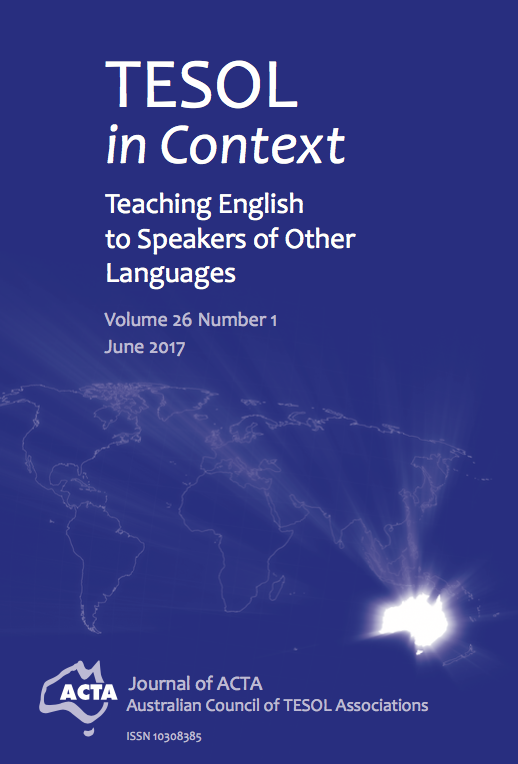Internationalising a school: teachers’ perspectives on pedagogy, curriculum and inclusion
DOI:
https://doi.org/10.21153/tesol2017vol26no1art704704Keywords:
internationalisation, overseas students, schools, ESL, pedagogyAbstract
The increase of internationalisation in Australian schools marks this as a significant teaching and learning experience for many teachers, specifically those in the secondary school. This case study of a secondary school investigated the concerns of teachers impacted by the implementation of an internationalisation policy. The study examined the teachers’ responses to issues often associated with internationalisation in schools: pedagogy, curriculum and student inclusion. Four key concerns emerged in the data: (i) feelings of being ill-prepared; (ii) questions about curriculum enactment and student participation; (iii) the need for greater intercultural competence; and (iv) a lack of clarity about the relationship between language and literacy. The paper explores the implications of these concerns for teachers’ practices and professional development as well as the place of international students in the school community.
Metrics
References
Adelabu, D. H. (2007). Time perspective and school membership as correlates to academic achievement among African American adolescents. Adolescence, 42(167), 525-538.
Alexander, R. (2008). Essays on pedagogy. London: Routledge.
Arends, R. I. (2009). Learning to teach (8 th ed.). New York: McGraw-Hill.
Australian Education International. (2014). Monthly summary of international student enrolment data - Australia. Retrieved 1 December 2014, from http://aei.dest.gov.au
Borich, G. D. (2011). Effective teaching methods: research-based practice (7 th ed.). Boston: Pearson Education, Inc.
Brigaman, K. J. (2002). The culturally diverse classroom: a guide for ESL and mainstream teachers., U.S. Pennsylvania.
Cazden, C.B. (2001). Classroom discourse: The language of teaching and learning (2nd. Ed). Portsmouth, NH: Heinemann.
Cheng, L., Myles, J., & Curtis, A. (2004). Targeting language support for non-native English-speaking graduate students at a Canadian university. TESL Canada Journal, 21(2), 50-71.
Creswell, J.W. (2014). Research design: qualitative, quantitative and mixed methods approaches. (4th ed.). Thousand Oaks, CA: Sage.
Creswell, J. W. (2009). Research design: qualitative, quantitative, and mixed methods approaches (3rd ed.). Thousand Oaks, CA: Sage Publications, Inc.
Dalton, S. S. (2008). Five standards for effective teaching: how to succeed with all students, grades K-8. San Francisco: Jossey-Bass.
Department of Education and Training (2015a). International students numbers 2014. Retrieved January 21, 2016 from https://internationaleducation.gov.au/research/Research-Snapshots/Documents/International%20Student%20Numbers%202014.pdf
Department of Education and Training (2015b). Monthly Summary of International Student Enrolment Data1 – Australia – YTD October 2015. Retrieved January 21, 2016 from https://internationaleducation.gov.au/research/International-Student-Data/Documents/Monthly%20summaries%20of%20international%20student%20enrolment%20data%202015/10_October_2015_MonthlySummary.pdf
Edwards-Groves, C., Anstey, M., & Bull, G. (2014). Classroom talk: Understanding dialogue, pedagogy and practice. Newtown, NSW: PETAA.
Faltis, C., & Wolfe, P. M. E. (1999). So much to say. adolescents, bilingualism, and ESL in the secondary school. New York: Teachers College.
Gibbons, P. (2002). Scaffolding language, scaffolding learning: teaching second language learners in the mainstream classroom. Portsmouth: Heinemann.
Grant, C. A., & Gillette, M. D. (2006). Learning to teach everyone’s children: equity, empowerment, and education that is multicultural. Toronto: Thomson Nelson.
Hammond, J. (Ed.). (2001). Scaffolding: teaching and learning in language and literacy education. Newton, NSW: Primary English Teaching Association (PETA).
Hanna, G. S. (2004). Assessment for effective teaching: using context-adaptive planning. Boston: Pearson.
Hattingh, S. (2015). A review of literature: what is an ideal internationalised school? Educational Review, DOI: 101080/00131911.2015.1087970.
Horwitz, E.K. (2013). Becoming a language teacher: a practical guide to second language learning and teaching (2nd ed). Boston: Pearson.
Hua, Z. (2011). The language and intercultural communication reader. London: Routledge.
Kettle, M. A. (2011). Academic practice as explanatory framework: reconceptualising international student academic engagement and university teaching. Discourse: Studies in the Cultural Politics of Education, 32(1), 1-14.
Killen, R. (2013). Effective teaching strategies: lessons from research and practice. (6th ed.). Melbourne: Cengage Learning.
Li, Y. (2004). Learning to live and study in Canada: stories of four EFL learners from China. TESL Canada Journal, 22(2), 25-43.
Love, K., & Arkoudis, S. (2004). Sinking or swimming?: Chinese international students and high stakes school exams. Australian Review of Applied Linguistics, 27(1), 58-72.
Luke, A. (1996). Genres of power? Literacy education and the production of capital. In R. Hasan & G. William (Eds.), Literacy in society (pp. 308-338). London: Longman.
Miller, J. (2003). Audible difference: ESL and social identity in schools. Clevedon, English: Multilingual Matters.
Muijs, D. (2005). Effective teaching: evidence and practice. London: Sage Publications.
Pawlas, G. E., & Oliva, P. F. (2008). Supervision for today’s schools. Hoboken: Wiley Publishing.
Popadiuk, N. (2010). Asian international student trasition to high school in Canada. The Qualitative Report, 15(6), 1523-1548.
Reeves, J. (2006). Secondary teacher attitudes toward including English-language learners in mainstream classrooms. The Journal of Educational Research, 99(3), 131-142.
Selinker, L., & Gass, S. M. (2008). Second language acquisition: an introductory course. New York: Taylor and Francis.
Sergiovanni, T. J., Kelleher, P., McCarthy, M. M., & Wirt, F. M. (2004). Educational governance and administration (5th ed.). Boston, MA: Pearson Education, Inc.
Smith, A. (2015). Huge increase in full-fee paying international students at NSW public schools. The Sydney Morning Herald, May 17, 2015. Retrieved 21 January, 2016 fromhttp://www.smh.com.au/national/education/huge-increase-in-fullfee-paying-international-students-at-nsw-public-schools-20150514-gh1lhg.html
State of Victoria (Department of Education and Training) (2015). Internationalising schools: A globalised future. Retrieved from http://www.education.vic.gov.au/about/programs/learningdev/Pages/connected.aspx
Taylor, J. & Branley, A. (2015). State schools cashing in on international student enrolments; 17 pc rise in overseas pupils in past year. ABC News_May 18, 2015. Retrieved 21 January, 2016 from http://www.abc.net.au/news/2015-05-18/state-schools-cashing-in-on-rise-in-international-students/6478566
Tudball, L. (2005). Grappling with internationalisation of the curriculum at the secondary school level: issues and tensions for educators. Australian Journal of Education, 49(1), 10-27.
Downloads
Published
Issue
Section
License
Copyright (c) 2017 TESOL in Context

This work is licensed under a Creative Commons Attribution-ShareAlike 4.0 International License.






